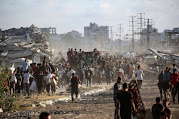"You are not going to spend money to harvest and not
have anyone to sell to," said grower Fabricio Vidal, from his farm in
Formoso, in the state of Minas Gerais.
The new tariffs could make it impossible for his fruit to
enter the United States, which buys 42% of the orange juice exported from
Brazil, a trade worth around US$1.31 billion in the season ending last June.
This month, orange prices in Brazil dropped to 44 reais (US$8)
a box, almost half of what they were a year ago, according to the widely
followed Cepea index from the University of Sao Paulo, illustrating how Trump's
disruptive trade policies can sow chaos even before enacted.
"As the day approaches in which tariffs will come into
effect, anxiety increases about what might happen," Ibiapaba Netto, the
head of orange juice exporter lobby CitrusBR, told Reuters in an interview.
US orange juice production dropped to its lowest level in
half a century in the 2024/25 harvest, with output estimated at 108.3 million
gallons, according to data from the United States Department of Agriculture
cited by Cepea, which shows imports will represent 90% of US supplies through
September.
US
consumers will bear the brunt along with Brazilian farmers. An astounding half
of the orange juice Americans drink comes from Brazil under household brands
such as Tropicana, Minute Maid and Simply Orange.
Brazil, which produces 80% of the world's orange juice, will
be hard to replace, too.
The US
has become more dependent on orange juice imports in recent years due
to the "citrus greening" crop disease, hurricanes and spells of
freezing temperatures.
But the new tariff on Brazilian imports represents a 533%
increase over the US$415 per ton duty levied on the country's juice now.
Last Friday, Johanna Foods, a New Jersey-based producer and
distributor of fruit juices, challenged in court the proposed tariffs on
Brazilian orange juice, claiming they would cause "significant and direct
financial harm" to the company and US consumers.
The tariffs may also spell trouble for Coca Cola and
Pepsi, which account for some 60% of the orange juice sold in the United
States, Netto said.
Brazil won't find it easy to replace American consumers,
some of the most avid orange juice drinkers in the world.
Typically, higher-income countries import orange juice,
limiting Brazil's potential reach into new markets. Brazilian orange juice is
only sold to some 40 nations – representing about a third of the destinations
that buy Brazilian meat, for example, according to trade data.
CitrusBR's Netto noted that hefty duties in markets such as India
and South Korea, as well as low household income in China, have hampered trade
with Brazil.
The European Union, in turn, already buys some 52% of
Brazil's total exports, making it unlikely that countries there will make up
for lost business with the US.
One would be to export Brazilian orange juice through Costa
Rica, which some companies already do to avoid the current duties, said Arlindo
de Salvo, an independent orange consultant. But it is unclear whether exporters
will be able to pull it off once the new levy starts being enforced.
As companies struggle to find new paths to consumers,
farmers in Formoso fear the worst. Prices have already dropped to about a third
of what growers were paid at this time last year, farmers said, making the cost
of picking oranges hardly worth the trouble.
Grower Ederson Kogler said that the only solution would be
to find other markets. But, he added, "These are things that don't happen
overnight."






